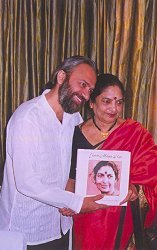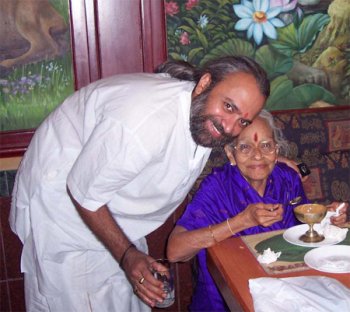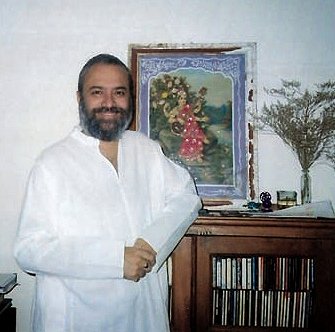
|
 |

|
 |
The medium is the message: Ashish Mohan Khokar - Lalitha Venkat, Chennai August 6, 2008 A reputed critic and dance-historian, editor-publisher of attendance and author of 34 books, Ashish Mohan Khokar is the son of late dance scholar / historian Mohan Khokar and veteran dance guru M K Saroja. The year 2008 is important for him since he has just published the tenth issue of India's only dance annual - ATTENDANCE, as well as released a bio pic of his mother titled BHARATANATYAM BHAKTA GURU M K SAROJA in the Gurus of India Dance Series. Known for his forthright views and unabashed way of writing, Ashish speaks to narthaki.com about his latest efforts and the dance scene in general.  How long has this book been in the making? THREE years....a good book takes a minimum 3-4 years to evolve, especially when the subject is deep and the material is vast and rich...The first in this series, Guru Maya Rao, was done 4 years ago and that took 3 years too. Next two in the making are one on Uday Shankar and one on Ram Gopal. If an institution supports us, I can bring out smaller ones on all greats and this will be the best service to dance heritage and history. By Goddess Saraswati's grace, I'm serving the art of dance. I'm convinced about that because, otherwise, I'm a very ordinary person but she has given me the craft and the courage to take up matters related to dance. What are the difficulties you encountered in compiling the book? The subject was too close to me and I had to be doubly objective. The first draft was in third person; later I realized her voice, in first person, worked much better. Two, her life was not hers alone but her gurus and her illustrious husband's too, as both were giants in the dance field. And then honesty had to be maintained all through. Most biographies are suspect because people, especially artistes, live in make-believe worlds, so important for creativity, yet such a pain for factual history. That's why the book is photo-driven because pictures don't lie! Imagine culling 400 pictures from a pool of 4000!! I had to be its photo-editor too and yet maintain the story. Then too, the book is a history of Bharatanatyam as it grew in the last century and showcases some of its key players - gurus, dancers, patrons and musicians. I had to be fair to all and equal. A real challenge was to create a readable book even for the non-dance person. After the launch, two readers called me next morning: One, Dr. Nageswaram, a family doctor, whose wife read it till 2am that morning before sleeping. He said, she said, she couldn't put it down! That for me is the ultimate compliment and real test of a good, readable book. One you can't put down. Second was my aunt G Sundari, a bully generally, who called me also to say, "Really Aashish, the book is very good, I have read it fully today itself." While writing, the fading memory of Saroja ma did not help. Most veterans don't remember dates or places they have performed in....for instance, the subject recalls performing for the King of Nepal, but the year escapes her. Was it 1971, 72 or 74? My second problem was too many pics to select from! Generally, a subject is not so well documented photographically, but in this case both her guru and husband (and later me, her son) have been avid photographers and documenters, thus her 70 years of dancing career is very handsomely documented. The book moves from sepia to black and white to colour, as decades move on.  What is the message you wish to convey through this book? The medium is the message. How an artiste has lived with honesty, dignity and integrity, all in short supply nowadays. That a great dancer can also be a great human being. That a dancer need not sacrifice family life for art. That goodness of heart is pre-requisite to goodness or greatness in and of art. Saroja ma's life and art reflects that and I'm not alone in saying that; many others have said it in the book, including on the day of the launch and these include three generation of dancers: Guru Kalanidhi Narayanana, diva Dr. Padma Subrahmanyam, Guru Adyar Lakhman, Guru Narasimhachari, Sundari, Leela Samson, Alarmel Valli..... Was it easy to find a publisher? I wish! India lacks dance-books publishers, it has none. Hence willy-nilly that role has been thrust on me now after many books (see attendance-india.com). I've taken that role, in addition to writing, designing and distributing! Publishers also mark-up book prices, atleast 4 times the actual price and few in India can afford dance books priced at Rs.2000 or 3000. Imagine, for this lavish book on German art mat-paper, 220 pages, hard-bound, colour, we are pricing at only Rs.700/- technically (published price Rs.1100/-) as we are giving 20% discount to art-lovers and students, institutions. Ditto attendance, now in its tenth year without any support and being sold for Rs.500/- only with same discount! Even with such low pricing, it is difficult to sell dance books. But I have made a start and continue to contribute to this field, I hope. In India, dancers rarely buy books unless they are glorified. What do you think is the future of dance books in India? Is there as big a readership for dance books as a writer wishes for? The future is sad...dancers don't read anything. Why, they can't even pay few hundred rupees for the few dance related journals that are brought out on dance - Sruti, Nartanam, Angarag and attendance (can't readily even recall the 5th one!). Issue after issue, editors write editorials saying please buy a copy, please subscribe but it falls on deaf ears! If all of us editors-publishers stop bringing these out, where will dancers get space or a forum? They don't realize that newspapers (except for few committed ones like The Hindu) are not interested in dance, especially classical. The best is over because there are no gurus either, just teachers. Despite all this, I'm still trying to create an interest in dance history through these books and will continue to do so. There is readership but mostly abroad, either foreigners or NRIs. Indians don't buy books and dancers buy only when and if they are featured, preferably on the cover!!! After the uphill task of completing 10 issues of attendance, do you plan to continue with it or?? If so, what would be the focus of your next annual? I'm glad you have said and noticed what an uphill task bringing a quality, hardbound book format dance annual is! It has taken my blood, sweat and toil but when I see it reach Xalapa in Mexico and Jullundhar in Punjab, I'm satisfied I'm on the right track. I also get many letters from Ph.D students, researches, even established authors who say what a feast attendance is for their work. Each issue is a book, not just a journal with arangetram pics! As editor-publisher, I also have complete independence and integrity to shape as I deem it fit. I'm helping dance debate and discussion, its history and heritage. Surely someone should care? And support. But god is there and I'm sure my guardian angels work overtime to see each year through. Now, in its tenth year, attendance is on auto-pilot! Even if I don't wish to do it, it gets done somehow. Wish more dancers/teachers/institutions bought it though and not make it a personal issue "Oh, I was not featured so I'm not buying it" lament. Next issue is being planned on Gurus of Indian Dance....real gurus, not teachers who run factories and make clones!  Any comments on the status of dance criticism in India? Let's put it in historical contexts to see how it has got diluted. Pre-independence, mostly foreigners wrote on Indian dance and for them everything was exotic. I would put travellers like Beryl de Zoete in that category. Then came dancers themselves like Ted Shawn, Anna Pavlova, La Meri, Nala Najan who did their bit and truly promoted Indian dance. A decade before Independence, in the overall clime of nationalism, we had E Krishna Iyer types of lawyers-turned-dancer activists who wrote too. G Venkatachalam wrote praisingly. But most of these names were bound and based by forms of the south. They knew precious little of north, east or west or folk forms. In that, the first true pioneer and inter-national writer on Indian dance is Mohan Khokar really, who wrote nationally and with in-depth authority on all forms, not just on Bharatanatyam or classical, like others did. He was as much an authority on folk, tribal, ritual forms as all classical forms. No one, except Kapila Vatsyayan can come even a close second to that kind of solid work. Mohan Khokar was no arm-chair writer but did much field work and photographed everything and wrote for foreign publications and Indian ones as vast as Free Press, Bhavan's Journal, The Illustrated Weekly of India, the Hindustan Times, Imprint, etc. He brought out the most definitive MARG volumes on each major classical form before others even came to dance writing and in addition, wrote 5 definitive books, which against all copyright norms are even now being photocopied! And to think he did all this honestly, without short-changing, bad-mouthing or putting anyone down personally like some of his followers did... And that he did all this while at M S University and Sangeet Natak Akademi, which too he served admirably. I am not alone in saying this, ask any one who truly knows dance history of last 50 years from that period. After him, Kapila Vatsyayan wrote extensively and did much field work because she was interested in the art of dance. She is a giant too. In the seventies Subuddu, T S Parthasarthy, Sunil Kothari, Shanta Serbjeet Singh were all established names who have served dance art. It is in the late eighties that the worst phase of dance writing began in India. No wonder, soon in the nineties, with onslaught of TV and other modes of entertainments like fashion, food, films, newspapers stopped promoting dance and now the scene is so bad that no one gives space for dance writing, except The Hindu in all its editions. Dance criticism today has become who gets on with whom. That should not be so. If critics play PR agents, it will definitely result in decline of dance criticism. A dancer can suffer not merely through the review but also in selection for festivals and trips abroad. Nowadays youngsters have no knowledge or staying power and nor do they wish to acquire it. For them, the initial name in print, the little importance and access they get to happening circles is a high and once that charm is gone, they move on to more paying professions, like news anchoring, TV or mainstream journalism. Dance writing is a very thankless task and a lonely journey, especially if one is honest and trying to serve and set standards in art. What about complaints of dwindling of funds for dancers, and space for dance coverage? Funds are not short; dancers are too many. Historically, in the 30s there were 3 greats in juts one form Bharatanatyam (Mylapore Gowri, Tanjore Gyanam and Bhanumati-Varalaskhmi); in the 40s, 4 greats (Rukmini Arundale, Bala, Ram Gopal and ?); in the fifties 5 greats (Kamala, Padmini, M K Saroja, Vyjayantimala and? ); in the 60s maybe 6 greats ( Indrani, Yamini, Padma Subrahmanyam, Kausalya, Sonal and ?); in the 70s maybe 7 but now every body is great!!! Where are the opportunities for all? Besides, classical dance has lost its pre-eminent place in society in the last ten years because few can do a margam properly and everyone who cannot, is doing experimental dance and then there are other avenues of entertainment, especially to the TV for audiences. Dancers haven't helped their cause by being perennial complainers, no matter what they get, they will still have some grouse. After Padma Shri they want Bharat Ratna! They are not doing a favour to society by being on stage, especially when they are barely good. A Bala or an MS we are willing to eat the dust of their feet, but ordinary mortals? Their self-indulgence is not a national responsibility of tax payers. This all has happened largely because of free pass or invite culture. Had there been tickets, like in the west, all will value the art and artiste more. Also, the market will decide what's good art, not just critics-cum-PR agents, because those who are just being self -indulgent would have little or no audience. Dance coverage has dwindled but that's because there's a paradigm shift in print media. That's why journals on dance are the only future and sites like these, best outreach! Do buy a dance journal (any or all, not just mine) and subscribe to dance sites like these. Your future as a dancer depends on these because mainstream print media has done enough in last 50 years to promote Indian dance and do not see any reason to continue to do so. The writing is on the wall. Ashish Khokar can be contacted at: khokar1960@gmail.com attendance-india.com |